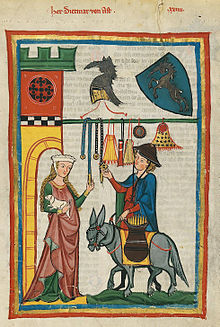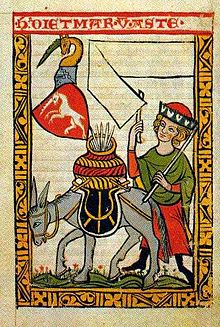Dietmar von Aist


Dietmar von Aist (* around 1115 ; † after 1171 ) was a minstrel from Upper Austrian , baronial sex and representative of Danube-country poetry, i.e. the early phase of German-language minstrel.
Life
Little is known about the poet's life. A Dietmar von Aist is mentioned by name from around 1139 in contemporary documents from Salzburg , Regensburg and Vienna . The name Aist probably refers to the river Aist , which in Austria feeds the Danube below the Enns . The lineage of the von Aist family is attested from around 1125 in Upper Austria, where the ruins of the ancestral seat are today on the Aist and in Aisterheim their moated castle, Schloss Aistersheim, built in 1136 . Whether Baron Dietmar de Aist, as attested in documents, was really the poet is uncertain for chronological reasons. A documented Ditmarus de Agasta who died around 1171 is possibly identical to Dietmar; The spellings Ayst and Eist can also be found in documents and later, when the line merges into that of Aistersheim, documents with the name Dietmar can also be found, such as around 1299. All this makes it difficult to clearly differentiate between people with the same name.
Works
Dietmar is credited with a number of songs, only a few of which his authorship can be clearly identified. A total of 16 minne songs with 42 stanzas have been handed down under his name. With the stanzas that can be safely assigned to it, it belongs to the earliest time of minstrel.
With his work Dietmar von Aist represents the link between the extra-courtly and courtly form. He used as one of the first refrains and changes.
The theme of his songs is mostly the relationship between men and women (love, separation, partnership), with some of his poems being written from a female perspective, others from a male perspective.
Ez stuont a frouwe alone
|
Ez stuont a frouwe alone |
A woman stood alone |
In Des Minnesangs Frühling this text is considered to be attributed to Dietmar, as it is "handed down in at least one ms. [...] under Dietmar's name".
The first recorded daily song Slâfest du, friedel ziere comes from his pen.
Individual evidence
- ↑ a b Hugo Moser, Helmut Tervooren (arr.): Des Minnesangs Frühling . 38th, revised edition. Hirzel, Stuttgart 1988, ISBN 3-7776-0448-8 , p. 59.
- ^ Translation of poems by Dietmar von Aist in the Codex Manesse ( Memento of the original of December 8, 2008 in the Internet Archive ) Info: The archive link has been inserted automatically and has not yet been checked. Please check the original and archive link according to the instructions and then remove this notice.
literature
Text output
- Hugo Moser, Helmut Tervooren (arr.): Des Minnesang's spring . 38th, revised edition. Hirzel, Stuttgart 1988, ISBN 3-7776-0448-8 , pp. 56-69.
Secondary literature
- Hugo Kuhn: Dietmar von Eist. In: New German Biography (NDB). Volume 3, Duncker & Humblot, Berlin 1957, ISBN 3-428-00184-2 , p. 675 ( digitized version ).
- Wilhelm Scherer: Dietmar von Eist . In: Allgemeine Deutsche Biographie (ADB). Volume 1, Duncker & Humblot, Leipzig 1875, p. 167.
- Joachim Bumke : History of German Literature in the High Middle Ages . dtv, Munich 1990, ISBN 3-423-04552-3 , pp. 85-86.
- Hans Fromm (Hrsg.): The German Minnesang: Essays on his research , Volume 1. Wissenschaftliche Buchgesellschaft, Darmstadt 1961; Volume 2, Wissenschaftliche Buchgesellschaft, Darmstadt 1985, ISBN 3-534-08604-X (= Paths of Research; Volume 608).
- Rolf Grimminger: Poetics of the early minstrel . CH Beck, Munich 1969 (= Munich texts and studies on German literature of the Middle Ages; Volume 27).
- Andreas Hensel: From early Minnesang to the poetry of Hohen Minne: Studies on the concept of love and the literary conception of the authors Kürenberger, Dietmar von Aist, Meinloh von Sevelingen, Burgrave von Rietenburg, Friedrich von Hausen and Rudolf von Fenis . Lang, Frankfurt am Main 1997, ISBN 3-631-31138-9 .
- Fritz Peter Knapp: German-language literature . In: Anna M. Drabek (Red.): Austria in the High Middle Ages (907 to 1246) . Publishing house of the Austrian Academy of Sciences, Vienna 1991, ISBN 3-7001-1861-9 , pp. 505-526 (= publications of the Commission for the History of Austria / Austrian Academy of Sciences; Volume 17).
- Alfred Romain: The songs of Dietmar von Eist . Univ., Diss., Leipzig 1911. (also in: Contributions to the History of German Language and Literature 37. 1912, pp. 349–431, 565.)
- Günther Schweikle: Minnesang . 2nd, corrected edition. Metzler, Stuttgart 1995, ISBN 3-476-12244-1 (= Metzler Collection; Volume 244).
- Helmut Tervooren: Dietmar von Aist . In: Author's Lexicon , Volume 2. 2nd edition. De Gruyter, Berlin 1980, ISBN 3-11-007699-3 , column 95-98.
- Ingo F. Walther (Ed.): Codex Manesse. The miniatures of the Great Heidelberg Song Manuscript . Insel, Frankfurt am Main 1989, ISBN 3-458-14385-8 .
- Herbert Zeman (Hrsg.): Literary history of Austria: from the beginnings in the Middle Ages to the present . Academic printing and Vlgs., Graz 1996, ISBN 3-201-01650-0 .
Web links
- Entry on Dietmar von Aist in the Austria Forum (in the AEIOU Austria Lexicon )
- Text by Dietmar von Aist (mhd./nhd.)
- Dietmar von Aist - full texts at eLib Austria
- Dietmar in Codex Manesse (digital copy from Heidelberg University Library)
- Poems by Dietmar von Aist in the Codex Manesse
- Dietmar von Aist, a discography at medieval.org (English)
- Entry on Dietmar von Aist by Florian Kragl for the Upper Austrian literary history of the StifterHaus
| personal data | |
|---|---|
| SURNAME | Dietmar von Aist |
| ALTERNATIVE NAMES | Dietmar von Eist |
| BRIEF DESCRIPTION | Austrian minstrel |
| DATE OF BIRTH | around 1115 |
| PLACE OF BIRTH | Upper Austria |
| DATE OF DEATH | after 1171 |